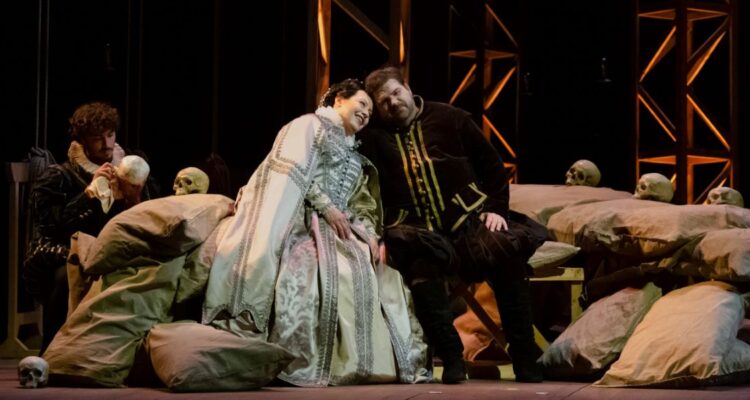The new production of Wagner’s “Tristan und Isolde” at Teatro Massimo di Palermo has generated significant anticipation. This is the first performance of the opera in Palermo in 40 years, and it features a stellar cast, including Nina Stemme, one of the foremost Wagnerian sopranos, performing Isolde for the final time in her career. Additionally, it marks the last season of the resident conductor Omer Meir Wellber.
Daniele Menghini’s direction is thought-provoking, showcasing several interesting concepts, though it lacks a cohesive thread. The stage opens on the bare structure of the theatre, revealing only backstage equipment: scaffolding, counterweight rigging, and sandbags. A long wooden table and a few people strumming the notes of the prelude add to the minimalist setting, creating an eerie atmosphere. The performance starts with a “theatre within a theatre” concept, where the main characters arrive in everyday clothes and change into their stage costumes during the performance, while actors in the background are rehearsing something else.
This approach leaves the opera suspended between reality and fiction. While intriguing, it ultimately feels confusing and lacks clear insight into Wagner’s ideas. Nevertheless, there are striking symbols, such as a naked Cupid/Angel symbolising the power of love, which appears several times during the performance.
The second act’s choices align more coherently with the opera’s philosophy. There are numerous Shakespearean allusions during Tristan and Isolde’s love duet: Hamlet’s skulls, two actors mimicking the “Romeo and Juliet” balcony scene, and a donkey character possibly from “A Midsummer Night’s Dream.” These elements highlight the dichotomy between reality and unfulfilled desires, a central theme of the opera. The contrast between day and night, another central theme, is also effectively conveyed through lighting choices. However, this conceptual exercise becomes tiresome by the third act, as the repetitive use of sandbags and bare staging fails to emotionally engage the audience. Only the final scene, clearly inspired by Bernini’s “Ecstasy of Saint Teresa,” provides a powerful rendition of the Liebestod (Love and Death).
Nina Stemme shines as Isolde, delivering a flawless performance that combines power and lyricism, deeply moving the audience, especially in the final aria. Witnessing her final stage performance in this signature role is a privilege. By contrast, Michael Weinius, as Tristan, disappoints; his interpretation lacks the nobility and passion required by the demanding role, and his thin voice struggles against the Wagnerian orchestra, at times resorting to shouting. Violeta Urmana stands out with a powerful vocal display as Brangäne. René Pape delivers an excellent performance as King Marke, exuding power and solemnity. Kurwenal, portrayed by Andrei Bondarenko, and Melot, portrayed by Miljenko Turk, also make strong impressions with their stage presence and nuanced interpretations.
The orchestra maintains a relentless rhythm and energy throughout this demanding score. The maestro conducts with decisiveness, and the orchestra responds with great dynamism and precision. However, in my opinion, the sound lacks the languishing and tension expected in this work, built on unresolved dissonances and harmonic suspension.
Overall, I recommend seeing this opera. The unique production choices, coupled with the opportunity to witness Nina Stemme’s final performance as Isolde, make it an experience worth having.
Teatro Massimo, Palermo, Italy
By Richard Wagner
Libretto: Richard Wagner
Conductor: Omer Meir Wellber
Director: Daniele Menghini
Cast: Nina Stemme, Michael Weinius, Violeta Urmana, René Pape, Andrei Bondarenko, and Miljenko Turk
Orchestra and choir of the Teatro Massimo di Palermo
Until the 31st of May 2024

